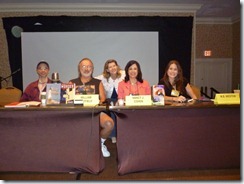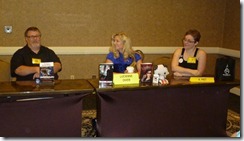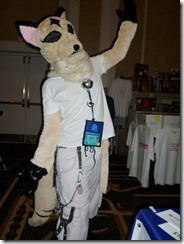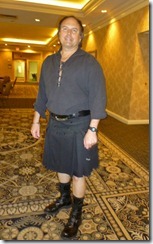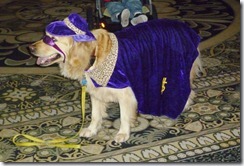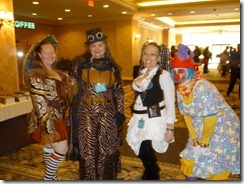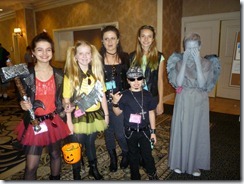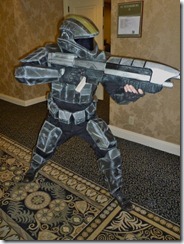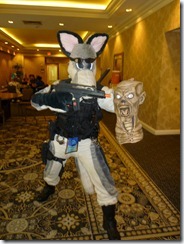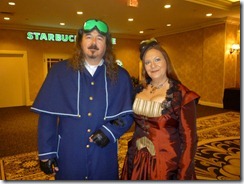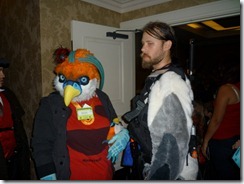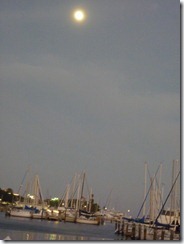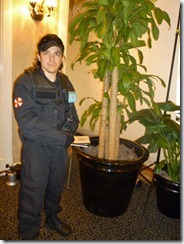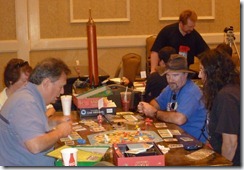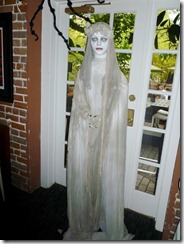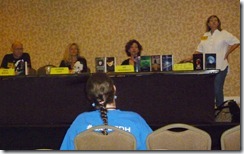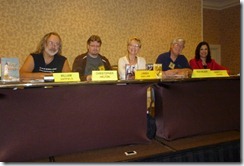Necronomicon, Part 2
Getting Started: Writing Believable Dialogue with Nick DiChario, K.L. Nappier, M.B. Weston, Nancy J. Cohen, and William Hatfield. A lot of good advice came from this panel. Be true to your character. Determine your target audience because it makes a difference in the language you can use. Listen to the people around you to get ideas for speech patterns. Read your material aloud to see if it sounds stilted. For more detailed advice, see my Blog on Writing Effective Dialogue. Below: Author Gary L. Zeiger and his lovely wife selling his book in the Dealers’ Room.
I skipped out next to roam around the hallways and to stop in to the hospitality room for a snack. You could attend such subjects as Higgs Boson [Particle] and You, Steampunk Invasion, Author/Publisher Contract Do’s and Don’ts, the Music of Science, and Anime Timeline. Then I met up with my husband for lunch and we strolled across the street where a farmer’s market was in full swing.
Why Sell Your Books to a Small Press with Eric Beebe, Lucienne Diver, Ed Howdershelt, and K. Piet. The reasons are many. First of all, Lucienne said the term Indie Author applies to writers who are published by an independent press. This is different from self-published and authors who are published by small presses or by vanity presses. One advantage of going with a small press is the individualized attention you get that you may not receive from one of the Big Six. You can build up your following and increase your readership. You may also have a say in your cover art. Discoverability is always an issue, so see what the small press publisher will do for you in terms of marketing.
Lucienne said the best chance for a high level of success is still with the big presses, with some exceptions. She discussed the agency versus the wholesale model in regard to pricing. Brick-and-mortar stores may devolve into smaller boutique shops over time. Humor can be a hard sell in today’s market, but anything erotic is still hot. Science fiction and fantasy aren’t doing as well in e-book format as romance and erotica, which are the biggest sellers. YA Paranormal doesn’t sell well in ebook either, because not all kids have e-reader devices. This genre is also hard to sell right now because Barnes & Noble has decreased demand for them.
Getting it Right: Paranormal Elements in Fiction with Nancy J Cohen, Lucienne Diver, Pamela Labud, Will Ludwigsen, and Brandy Stark. As I was on this panel, I didn’t take notes but we each talked about the elements we use in our fiction. My new series deals with Norse mythology. Being consistent in your world building is essential.
Getting Started: Writing Fight Scenes with Richard Byers, Johanna Bolton, R.M. Garcia, T.S. Robinson, Michael Joy, and William Logan. One of the recommendations is to give glimpses of your hero’s special ability along the way. Build anticipation and get to know your villains. Johanna writes spaceship battles, and she visualizes the scene ahead of time. Richard suggests that you consider the level of realism you want to achieve. Consider scene length also. Is this meant to be the grand finale or merely a build-up to the end? The fight scene should have a purpose, such as showing team work. And don’t forget physics. When you hit a wall, what happens? Does the wall crack? What are the results on your body? Michael says his fight scenes serve as the action around the dialogue.
Problem areas can be giant battle scenes with multiple armies, unfamiliar technology, mercenaries for hire, psychic combat, lack of experience with weapons. What are some common mistakes? If you use very specific terms such as Japanese martial arts moves, you are appealing to a narrow audience. Either rename the move or qualify it through action. A general audience won’t understand the jargon. Fight scenes can go on too long. Get back to the people. Factual errors can be a problem, like when the gun is putting out the wrong caliber bullet. Or the choreography can be wrong. Make sure the sequence of events is physically possible. Also if somebody gets killed, give a definitive ending for that person before the story moves on. And remember that injuries need time to heal. It’s unrealistic when your hero pops up the next day after a major fight scene, and he’s perfectly fit.
Your hero’s background will determine how he approaches the scene. A trained fighter will observe how the enemy holds his weapon, and that may tell the hero how to confront the guy or if it’s wiser to get out of his way. Women can fight for different reasons than men, so keep that in mind. Alternate moments of high tension with those of low tension but don’t ever completely let go.
<><><>
On Saturday night, the Masquerade brought out characters in all sorts of costumes, including the bagpipe artist in a kilt and the dog. We skipped outside to have dinner at a restaurant just past the yacht club and alongside the marina. It was breezy but clear with a full moon. I’d had a great time but left early Sunday to head over toward Orlando and a revisit to the Epcot Food & Wine Festival.
